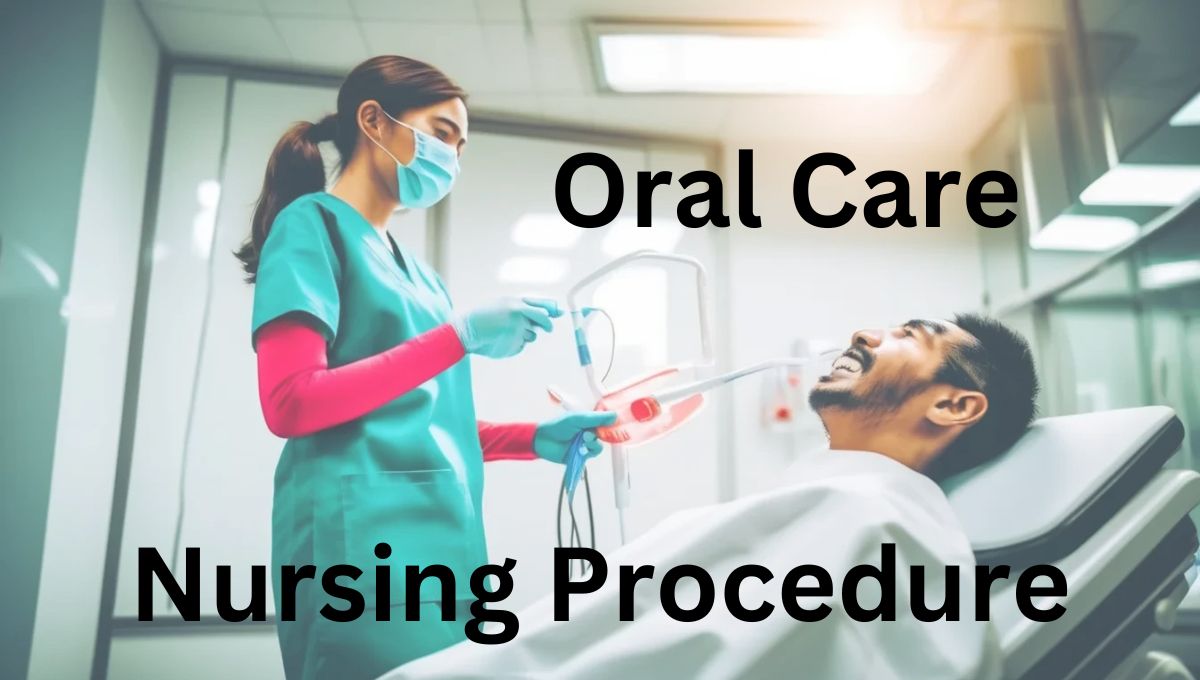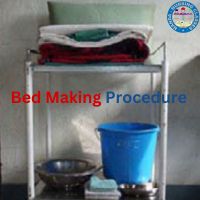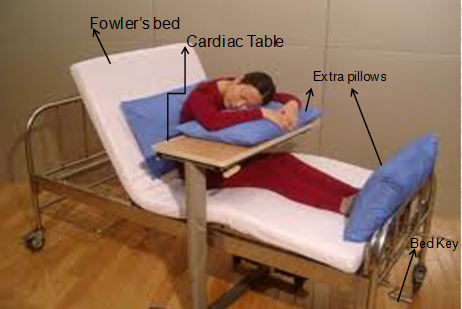Self-oral care for admitted persons in hospitals is difficult due to their different health conditions, so nurses have to help them with the care of oral cavities with skills. Oral care is an essential aspect of nursing care that ensures the maintenance of oral hygiene and prevents complications related to the oral cavity. Proper oral care is crucial for both conscious and unconscious patients to maintain overall health and well-being. here we bring for you the complete guide to oral care let’s learn “Oral Care nursing procedure“-
Oral Care Definition
Oral care nursing procedure refers to the systematic process of cleaning the mouth, teeth, gums, and tongue of a patient to prevent infection, promote comfort, and maintain oral health.

Oral Care Purposes
- To prevent oral infections and dental caries
- To promote comfort and well-being
- To prevent halitosis (bad breath)
- To maintain the integrity of oral tissues
- To enhance appetite and nutritional intake
- To prevent complications such as pneumonia, especially in ventilated patients
Oral Care Indications
- All hospitalized patients
- Patients with limited mobility or dexterity
- Patients with cognitive impairments
- Patients on mechanical ventilation
- Patients receiving oxygen therapy
- Patients undergoing chemotherapy or radiation therapy
- Postoperative patients
Articles Used in the Oral Care Procedure
- Toothbrush (manual or electric)
- Toothpaste
- Mouthwash
- Dental floss
- Suction catheter (for unconscious patients)
- Tongue depressor
- Basin
- Gloves
- Towel
- Lip balm
- Oral swabs
- Water
Oral Care Nursing Procedure
| Steps | Rationale |
|---|---|
| 1. Explain the procedure to the patient to gain cooperation and reduce anxiety. | · Providing information fosters cooperation, understanding and participation in care |
| 2. Gather all necessary equipment to ensure efficiency. | · Organization facilitates accurate skill performance |
| 3. Close door and /or put screen | · To maintain privacy |
| 4. Perform hand hygiene and wear gloves to prevent infection. | · To prevent the spread of infection |
| 5. If you use solutions such as sodium bicarbonate, prepare solutions required. | · Solutions must be prepared each time before use to maximize their efficacy |
| 6. Assist the patient to a comfortable sitting or semi-Fowler’s position to prevent aspiration and ensure access to the oral cavity. | · To promote his/her comfort and safety and
effectiveness of the care including oral inspection and assessment |
| 7. Inspect oral cavity
a. Inspect whole the oral cavity ,such as teeth, gums, mucosa and tongue, with the aid of gauze-padded tongue depressor and torch b. Take notes if you find any abnormalities, e.g., bleeding, swollen, ulcers, sores, etc. |
· Comprehensive assessment is essential to determine individual needs · Some clients with anemia, immunosuppression, diabetes, renal impairment epilepsy and taking steroids should be paid attention to oral condition. They may have complication in oral cavity. |
| 8. Place face towel over the client chest or on the thigh with mackintosh | · To prevent the clothing form wetting and not to give uncomfortable condition |
| 9. Put kidney tray in hand or assist the client holding a kidney tray | · To receive disposal surely |
| 10. Instruct the client to brush teeth Points of instruction
a. Client places a soft toothbrush at a 45 °angle to the teeth. b. Client brushes in direction of the tips of the bristles under the gum line with tooth paste. Rotate the bristles using vibrating or jiggling motion until all outer and inner surfaces of the teeth and gums are clean. c. Client brushes biting surfaces of the teeth d. Client clean tongue from inner to outer and avoid posterior direction. |
· Effective in dislodging debris and dental plaque from teeth and gingival margin
· Cleansing posterior direction of the tongue may cause the gag reflex |
| 11. If the client cannot tolerate toothbrush (or cannot be available toothbrush), form swabs or cotton balls can be used | · When the client is prone to bleeding and/or pain, tooth brush is not advisable |
| 12. Rinse oral cavity
a. Ask the client to rinse with fresh water and void contents into the kidney tray. b. Advise him/her not to swallow water. If needed, c. suction equipment is used to remove any excess. |
· To make comfort and not to remain any fluid and debris · To reduce potential for infection and |
| 13. Ask the client to wipe mouth and around it. | · To make comfort and provide the well-appearance |
| 14. Confirm the condition of client’s teeth, gums and tongue. Apply lubricant to lips. | · To moisturize lips and reduce risk for cracking |
| 15. Rinse and dry tooth brush thoroughly. Return the proper place for personal belongings after
drying up. |
· To prevent the growth of microorganisms |
| 16. Replace all instruments | · To prepare equipment for the next procedure |
| 17. Discard dirt properly and safety | · To maintain standard precautions |
| 18. Remove gloves and wash your hands | · To prevent the spread of infection |
| 19. Document the care and sign on the records. | · Documentation provides ongoing data collection and coordination of care
· Giving signature maintains professional accountability |
| 20. Report any findings to senior staff | · To provide continuity of care |
Oral Care Nursing Procedure with Unconscious Patient
| Steps | Rational |
|---|---|
| 1. Check client’s identification and condition | Providing nursing care for the correct client with appropriate way. |
| 2. Explain the purpose and procedure to the client | Providing information fosters cooperation and understanding |
| 3.Perform hand hygiene and wear disposable gloves | To prevent the spread of infection. |
| Prepare equipments:Collect all required equipments and bring the articles to the bedside.Prepare sodium bicarbonate solutions in gallipot. ❖Nursing Alert❖ If the client is unconscious, use plain tap water. Soak the cotton ball in sodium bicarbonates solution(3 pinches / 2/3 water in gallipot) with artery forceps.Squeeze all cotton balls excess solution by artery forceps and dissecting forceps and put into another gallipot | Organization facilitates accurate skill performanceSolutions must be prepared each time before use to maximize their efficacyTo reduce potential infectionCleaning solutions aids in removing residue on the client’s teeth and softening encrusted areas.To avoid inspiration of the solution |
| 5. Close the curtain or door to the room. Put screen. | It maintains the client’s privacy |
| 6. Keep the client in a side lying or in comfortable position. | Proper positioning prevents back strainTilting the head downward encourages fluid to drain out of the client’s mort and it prevents aspiration. |
| 7. Place the mackintosh and towel on the neck to chest. | The towel and mackintosh protect the client and bed from soakage. |
| 8. Put the kidney tray over the towel and mackintosh under the chin.(Fig. 18) | It facilitates drainage from the client’s mouth. |
| Inspect oral cavity: Inspect whole the oral cavity, such as teeth, gums, mucosa and tongue, with the aid of gauze-padded tongue depressor and torch. Take notes if you find any abnormalities, e.g., bleeding, swollen, ulcers, etc. | Comprehensive assessment is essential to determine individual needs.Some clients with anemia, immunosuppression, diabetes, renal impairment, epilepsy and taking steroids should be paid attention to oral condition. They may have complication in oral cavity. |
| 10. Clean oral surfaces: (Fig.19) 1) Ask the client to open the mouth and insert the padded tong depressor gently from the angle of mouth toward the back molar area. You never use your fingers to open the client’s mouth. 2) Clean the client’s teeth from incisors to molars using up and down movements from gums to crown. 3) Clean oral cavity from proximal to distal, outer to inner parts, using cotton ball for each stroke. | The tong depressor assists in keeping the client’s mouth open. As a reflex mechanism, the client may bite your fingers. Friction cleanses the teeth. |
| 11. Discard used cotton ball into small kidney tray. | To prevent the spread of infection. |
| 12. Clean tongue from inner to outer aspect. | Microorganisms collect and grow on tongue surface and contribute to bad breath. |
| Rinse oral cavity: Provide tap water to gargle mouth and position kidney tray.If the client cannot gargle by him/herself, rinse the areas using moistened cotton balls or insert of rubber tip of irrigating syringe into the client’s mouth and rinse gently with a small amount of water. Assist to void the contents into kidney tray. If the client cannot spit up, especially in the case of unconscious client, suction any solution. | To remove debris and make refresh Rinsing or suctioning removes cleaning solution and debris.Solution that is forcefully irrigated may cause aspiration To avoid aspiration of the solution |
| 14. Confirm the condition of client’s teeth, gums, mucosa and tongue. | To assess the efficacy of oral care and determine any abnormalities |
| 15. Wipe mouth and around it. Apply lubricant to lips by using foam swab or gauze piece with artery forceps | Lubricant prevents lips from drying and cracking. |
| 16. Reposition the client in comfortable position. | To provides for the client’s comfort and safety. |
| 17. Replace all equipments in proper place. | To prepare equipments for the next care |
| 18. Discard dirt properly and safety | To maintain standard precautions |
| 19. Remove gloves and perform hand hygiene | To prevent the spread of infection |
| 20. Document the care and sign on the records. | Documentation provides ongoing data collection and coordination of care.Giving signature maintains professional accountability |
| 21. Report any findings to the senior staff. | To provide continuity of care |
Oral Care Procedure Complications
- Aspiration of fluids or debris, especially in unconscious patients
- Oral infections if not performed regularly
- Injury to oral tissues from improper technique
- Discomfort or pain during the procedure
Oral Care Procedure Summary
Oral care is a critical nursing procedure that helps maintain oral hygiene, prevent infections, and promote patient comfort. The procedure varies slightly between conscious and unconscious patients, with specific considerations for positioning and techniques to prevent complications. Regular and proper oral care contributes significantly to the overall health and well-being of patients.
FAQs
Q1: How often should oral care be provided to hospitalized patients?
Oral care should be provided at least twice daily for all hospitalized patients and more frequently for those with specific needs or risks.
Q2: What should be done if a patient is resistant to oral care?
It’s important to explain the importance of oral care to the patient, use a gentle approach, and consider involving a family member or caregiver to assist. In some cases, alternative methods or timing may be necessary.
Q3: Can a mouthwash replace brushing for oral care?
No, mouthwash can complement brushing but cannot replace it. Brushing is essential to remove plaque and debris from the teeth surfaces.
Q4: What are the signs of oral infections to watch for?
Signs of oral infections include redness, swelling, pain, bad breath, sores, or pus in the mouth. Any of these symptoms should be reported and addressed promptly.
Q5: Why is oral care important for unconscious patients?
Oral care is crucial for unconscious patients to prevent infections, maintain tissue integrity, and reduce the risk of aspiration pneumonia.




Thanks for the sensible critique. Me and my neighbor were just preparing to do some research about this. We got a grab a book from our local library but I think I learned more clear from this post. I’m very glad to see such excellent info being shared freely out there.
Hi my loved one! I wish to say that this post is awesome, great written and include almost all vital infos. I?¦d like to look extra posts like this .
This web site is really a walk-through for all of the info you wanted about this and didn’t know who to ask. Glimpse here, and you’ll definitely discover it.
Hello, i read your blog occasionally and i own a similar one and i was just curious if you get a lot of spam feedback? If so how do you stop it, any plugin or anything you can recommend? I get so much lately it’s driving me insane so any help is very much appreciated.
I’m not that much of a internet reader to be honest but your blogs really nice, keep it up! I’ll go ahead and bookmark your site to come back down the road. Many thanks
I’m not sure if this is a format issue or something to do with internet browser compatibility but I figured I’d post to let you know. The style and design look great though! Hope you get the issue fixed soon. Many thanks